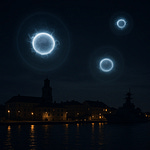TL;DR: This block’s precision cut and unusual surface texture are not just primitive stonework — from a Frequency Wave Theory (FWT) perspective, it’s the visible fossil of vibrational engineering. Ancient builders used resonance fields to “soften” or re-align crystalline bonds, allowing stones to be cut, shaped, and fused with a precision that still defies conventional tools.
The Block and Its Unnatural Finish
The image shows a squared stone with sharp edges and a porous, almost aerated texture. To mainstream archaeology, this might look like weathered volcanic rock or simple tool wear. But under FWT, the surface tells a different story: resonance machining. When vibrational energy is tuned into the natural frequency of a stone’s lattice, it destabilizes bonds temporarily — creating a softened, almost “foamed” texture as energy escapes. The edge geometry reveals intentional shaping, not random fracture.
Resonance Softening vs. Mechanical Carving
Conventional explanation: Chisels, pounding stones, abrasion.
FWT explanation: Frequency-driven bond relaxation. High-intensity sound waves or plasma resonance fields momentarily reduce the cohesion of atomic lattices, turning hard stone into a malleable state. Instead of “cutting,” the ancients tuned the block into a frequency where it could be shifted, molded, or broken along clean resonance nodes.
That porous appearance is exactly what you’d expect if excess vibrational energy bled off as the lattice temporarily expanded and reorganized.
Precision Geometry as Cymatic Echo
The sharp, almost manufactured corner suggests geometry guided by cymatic resonance. When you drive a material at standing-wave frequencies, matter reorders itself into nodal planes. That’s why ancient blocks often appear as if “cast” rather than chipped. The corners form where the frequency nodes intersect — geometry emerging directly from vibration.
Why This Matters for FWT
This single block encapsulates three FWT principles:
Matter = frozen frequency field → stone is a standing wave crystallized in mineral form.
Resonance manipulation = tool → tuning into the lattice frequency allows manipulation without brute force.
Cymatic geometry = blueprint → shapes, angles, and edges emerge from harmonic interference patterns, not chisels.
What we’re seeing here is an ancient artifact of vibrational engineering — a literal “frequency fossil.”










